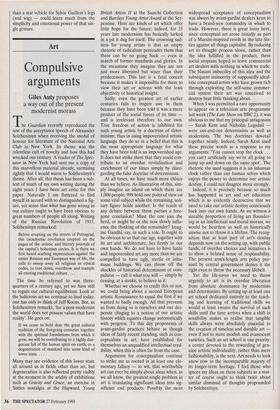Dance
Royal Ballet (Covent Garden)
Given the runaround
Sophie Constanti
David Bintley's new ballet, Tombeaux, follows the recent announcement that he is, apparently by mutual consent, to be `released' from his position as the Royal Ballet's resident choreographer. Yet Bint- ley's departure could hardly be described as absolute: he has pledged his loyalty to the two Royal Ballet companies and will continue to make works for both. Tombeaux — the centrepiece of a triple bill which opens with Fokine's The Firebird and ends, on an abrupt note, with William Forsythe's In the middle, somewhat elevated — is not a farewell gift, but merely the end marker of a phase in Bintley's career dur- ing which he was sold as the choreographer most capable of filling the void left after
Ashton's death. At the very least, he could be trusted to pump up the repertoire with suitably inoffensive ballets.
Ironically, it was Kenneth MacMillan's raw and violent The Judas Tree, created when the choreographer was in his sixties, that finally confronted the Royal Ballet and its audiences with the real world. Nothing produced by Bintley, since his appointment to resident choreographer in 1986, has had such force or resonance. His eclecticism, seen in the range of his output — from Hobson's Choice to Galanteries, from 'Still Life' at the Penguin Café to Tombeaux has always been Bintley's winning card. He is a proficient all-rounder with a predilec- tion for quoting Ashton and Balanchine but whose every ballet is stained with bland conventionality.
Tombeaux, set to William Walton's Vari- ations on a Theme by Hindemith and designed by Jasper Conran, takes place in front of a series of layered backcloths based on a painting by Patrick Kinmonth. Ordered on a visible grid is a barren land- scape of dead, twisted, black tree trunks, relieved only by rolling mists of blue and green and by a gateway fashioned in the image of a yawning lion's head.
Apart from its setting, Tombeaux brings to mind Ashton's Scenes de ballet. Conran's tutus, with their velvet bodices bleeding into stiff skirts, have the same chic appeal that Andre Beaurepaire's costumes for Scenes might have had in 1948, but Bintley seems to be using Ashton's ballet as a model of construction rather than one of mood, atmosphere or style. As in Scenes, there is a central couple (Viviana Durante and Bruce Sansom), a quartet of men (all four selected by Bintley danced in last year's performances of Scenes) and a female corps (numbering ten women instead of Ashton's 12). But while Scenes is a glorious, three- dimensional picture of sonorous formality weighted with undercurrents of mystery, Tombeaux is frequently flat, polite and throwaway. What stops it from being a for- gettable irrelevance is Bintley's response to the score. He engages with every twist and turn of the theme, variations and finale of Walton's (and Hindemith's) music and, at times, his choreography is almost as sensi- tively modulated. Indeed, there are moments of startling originality and effect.
Take, for instance, the slow, soft, travel- ling knee-bends executed by Durante as she leans against Sansom; or the bold verti- cal created by Sansom turning Durante upside down and hoisting her above his shoulders; or the final, exuberant state- ments for the entire corps which, like Ash- ton's writing in Scenes, could be studied from any angle. And in the parting pas de deux, Bintley creates a sempiternal point of focus as Sansom runs in circular pathways around Durante before trailing away and exiting. Unlike, say, Balanchine's Symphony in C, Bintley's ballets are often rendered lightweight by their sheer volume of activi- ty. Such phrases of busy movement afflict Tombeaux but, ultimately, the work is saved by what could be Bintley's attention to Walton's remark about one's eraser being more important than one's pencil.
In The Firebird, title role performances by Fiona Chadwick and Nina Ananiashvili — partnered, respectively, by Adam Coop- er and Stuart Cassidy — compensated for the fake folksiness of the Russian dances. And the trip through Kostchei's enchanted garden, crowded with colourful misfits, is made worthwhile by Fokine's final tableau: the marriage of the Tsarevna and Ivan, cul- minating as Ivan raises his hand to the skies. Bintley — and Forsythe, whose In the middle, somewhat elevated is little more 'A grown man getting into all those undignified positions . . than a star vehicle for Sylvie Guillem's legs (and wig) — could learn much from the simplicity and emotional power of that sin- gle gesture.



















































 Previous page
Previous page